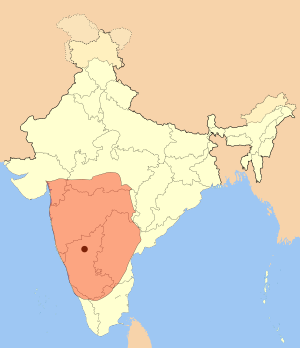 Image via Wikipedia
Image via Wikipedia
- The Chalukya Empire was an Indian royal dynasty that ruled large parts of southern and central India between the 6th and the 12th centuries. During this period, they ruled as three related, but individual dynasties. The earliest dynasty, known as the "Badami Chalukyas", ruled from their capital Vatapi (modern Badami) from the middle of the 6th century. The Badami Chalukyas began to assert their independence at the decline of the Kadamba kingdom of Banavasi and rapidly rose to prominence during the reign of Pulakesi II. After the death of Pulakesi II, the Eastern Chalukyas became an independent kingdom in the eastern Deccan. They ruled from their capital Vengi until about the 11th century. In the western Deccan, the rise of the Rashtrakutas in the middle of 8th century eclipsed the Chalukyas of Badami before being revived by their descendants, the Western Chalukyas, in late 10th century. These Western Chalukyas ruled from Kalyani (modern Basavakalyan) till the end of the 12th century.
- Hiuen-Tsiang, a Chinese traveller had visited the court of Pulakesi II. At the time of this visit, as mentioned in the Aihole record, Pulakesi II had divided his empire into three Maharashtrakas or great provinces comprising of 99,000 villages each. This empire possibly covered present day Karnataka, Maharashtra and coastal Konkan.
- Pulakesi II is the most famous ruler of the Chalukya dynasty. In his reign the Chalukyas of Badami saw their kingdom extend over most of the Deccan.
- The Chalukyas ruled over the Deccan plateau in India for over 600 years. During this period, they ruled as three closely related, but individual dynasties. These are the "Chalukyas of Badami" (also called "Early Chalukyas"), who ruled between the 6th and the 8th century, and the two sibling dynasties, the "Chalukyas of Kalyani" (also called Western Chalukyas or "Later Chalukyas") and the "Chalukyas of Vengi" (also called Eastern Chalukyas).
- The Aihole inscription of Pulakesi II (634) written by his court poet Ravikirti in Sanskrit language and Kannada script is considered as an excellent piece of poetry. A few verses of a poetess named Vijayanaka who describes herself as the "dark Sarasvati" has been preserved. It is possible that she may have been a queen of prince Chandraditya (a son of Pulakesi II).
- The rule of the Western and Eastern Chalukyas, however, is a major event in the history of Kannada and Telugu literatures respectively. By the 9th–10th centuries, Kannada language had already seen some of its most notable writers. The "three gems" of Kannada literature, Adikavi Pampa, Sri Ponna and Ranna belonged to this period.
- The army was well organised and this was the reason for Pulakesi II's success beyond the Vindyas.It consisted of an infantry, a cavalry, an elephant corps and a powerful navy. The Chinese traveller Hiuen-Tsiang wrote that the Chalukyan army had hundreds of elephants which were intoxicated with liquor prior to battle. It was with their navy that they conquered Revatidvipa (Goa), and Puri on east coast of India. Rashtrakuta inscriptions use the term Karnatabala when referring to the powerful Chalukya armies.

